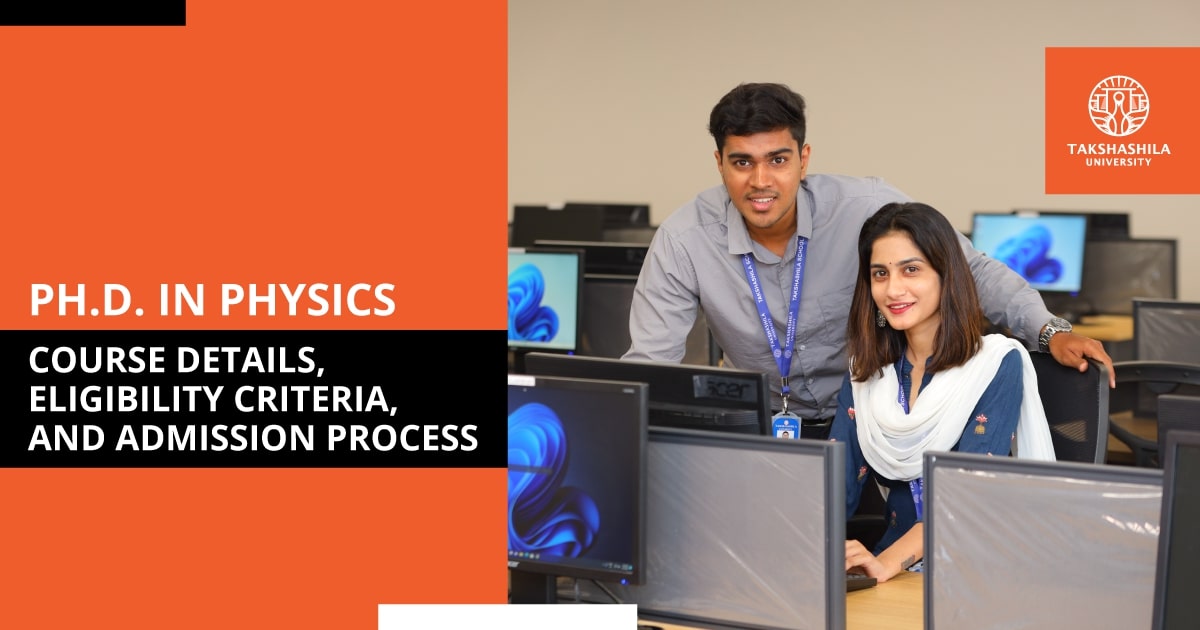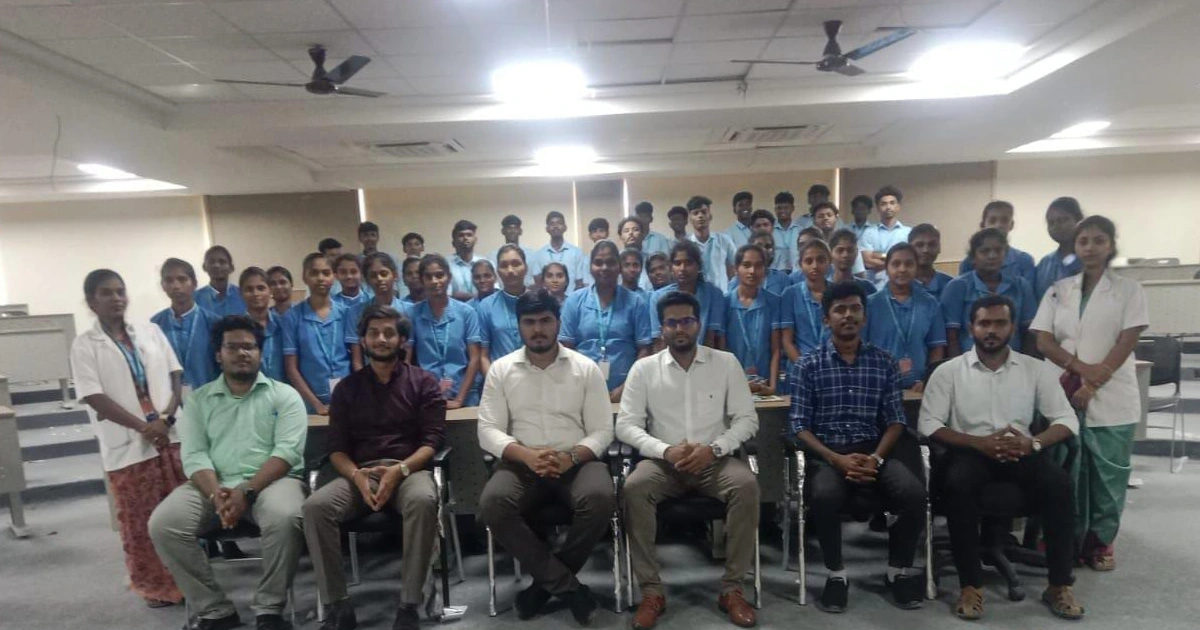If you are passionate about learning and researching the core fundamentals of physics, then choose a Ph.D. in Physics. This course gives you a solid understanding of advanced research skills and future expertise in areas such as quantum mechanics, astrophysics, and nanotechnology. We will also discuss the benefits of pursuing this degree, possible job roles, and innovations in the field.
Physics, the analysis of matter and energy, plays a key role in understanding the natural world and technological advancements. The courses include broad coursework, real-time projects, laboratory sessions, and opportunities to collaborate on global projects.
This blog analyses what PhD students need to know about courses like a PhD in Physics, including course structure, eligibility, and admission process.
Course Details
The syllabus for a PhD in Physics typically covers advanced concepts and quantum functions. At Takshashila University, the programme is designed to provide students with the best theoretical and experimental physics education. The course usually involves:
- Core Courses: These cover fundamental topics such as quantum mechanics, classical mechanics, electromagnetism, and statistical physics.
- Research Methodologies: Students will study with advanced research techniques and data analysis, which are essential for article submission for original research.
- Specialised Electives: Depending on their research interests, students can choose from various electives such as condensed matter physics, astrophysics, biophysics, and nanotechnology.
- Research Project: A significant part of the PhD involves conducting original research and topping in a dissertation. This requires students to identify a novel research question, design experiments, gather correct data, and effectively analyse results based on the research.
- Seminars and Presentations: Throughout the programme, students are prepared to present their work samples, like research papers and articles in workshops, to submit. Based on that, they can represent innovation and professional development.
Eligibility Criteria
To apply for a PhD in Physics at Takshashila University, candidates must meet specific eligibility criteria, ensuring they have the required academic background and research potential.
The typical requirements include:
- Educational Background: Candidates should hold a master’s degree in Physics or a closely related field, such as Engineering Physics or Applied Physics, with a minimum percentage or CGPA requirement that may vary by application year.
- Entrance Examination: Most institutions, including Takshashila University, require candidates to pass an entrance examination designed to test their grasp of advanced topics in physics and research methodology.
- Research Proposal: Applicants need to submit a research proposal summarising their planned area of study and explaining their understanding of the topic and its relevance to the field of physics.
- Interviews: Shortlisted candidates may be invited for an interview, where they can discuss their research interests and academic background with department faculty members.
Admission Process
The admission process for the PhD in Physics at Takshashila University is well structured to select candidates passionate about good academic performance and strong research techniques.
Here’s a step-by-step guide to the admission process:
- Application Submission: Interested candidates must complete an application form available on the Takshashila University website. The form requires details about previous academic performances, examination scores, and supporting documents.
- Entrance Exam Registration: Candidates should register for the university’s entrance examination per the specified dates.
- Prepare for the Entrance Exam: Candidates should prepare for the entrance exam covering core physics principles and research skills.
- Interview Invitation: Candidates who perform well in the entrance examination will receive an invitation to interview with faculty members from the Head of the Physics department.
- Final Selection: Following interviews, successful candidates will be notified of their admission status, after which they must complete the enrolment process, including payment of fees and registration.
Benefits of Doing a Ph.D. in Physics
- Advanced Knowledge and Expertise: A PhD in Physics provides advanced knowledge of complex concepts, spot-on decision-making, and problem-solving skills.
- Research Opportunities: Beyond academics, students are connected to the latest trends and tech software for research, which certainly gives them a new way of approaching new inventions and discoveries.
- Career Opportunities: Graduates are well-prepared for careers in academic, industry, and research institutions. They may work as professors, researchers, or in R&D departments of various companies, including government projects.
- Contribution to Society: Physics plays a role in the new tech domain, addressing social challenges, from renewable energy solutions to medical technology equipment or instruments. Ph.D. graduates can best contribute to these fields.
- Networking and Collaboration: During their studies, PhD candidates have numerous opportunities to collaborate with Top physicists and established professionals, developing their professional network
Job Roles for PhD in Physics Graduates
Graduates with a Ph.D. in Physics have various career opportunities across multiple sectors. Some typical roles include:
- Academic Researcher: Many PhD holders work in universities, researching and teaching future scientists.
- Industrial Physicists: In the private sector, industrial physicists may work in research and development, using their knowledge to innovate products and processes.
- Data Scientist: With their analytical skills, physics PhD graduates are highly demanded in data science roles, where they can apply statistical methods to large data sets.
- Government Research Scientists: Many are hired by government labs and agencies and contribute to national scientific initiatives and advancements.
- Consultant: Some work as consultants based on their choice and experience. Through their advice/ ideas/suggestions, businesses and governmental entities apply technical terms.
Innovation Products in Physics
Physics is fundamentally related to innovation across multiple sectors, leading to the development of new technologies. Key innovations include:
- Lasers: Derived from principles of quantum mechanics, lasers have transformed various fields, including medicine, communications, and manufacturing.
- Semiconductors: The physics of materials has directed the development of semiconductors, which are central to electronics, computing, appliances and telecommunications.
- Nanotechnology: Physicists are at the Head of handling at the atomic level, guiding advancements in materials science, medicine, and energy efficiency.
- Renewable Energy Technologies: Innovations such as solar panels and wind turbines are heavily developed on principles of physics, advancing the new form towards sustainable energy sources.
Salary range of Ph.D. in Physics professionals
| Job Role | Salary Range (INR per annum) | Branch of work |
| Academician (Professor/ Lecturer) | ₹5,00,000 – ₹12,00,000 | World class best like institutions IITs/NITs offering higher packages. |
| Research Scientist | ₹6,00,000 – ₹15,00,000 | Primarily in organisations like ISRO, DRDO, or private R&D labs. |
| Data Scientist | ₹8,00,000 – ₹20,00,000 | Current high demand roles for data expertise in retail, healthcare, IT industries. |
| Medical Physicist | ₹6,00,000 – ₹12,00,000 | Work in healthcare sectors, focusing on radiation technologies. |
| Aerospace Engineer (Research) | ₹10,00,000 – ₹20,00,000 | Advanced physics applications in the aviation and space research domain. |
| Industrial Physicist | ₹7,00,000 – ₹18,00,000 | Roles in manufacturing, materials, and engineering industries. |
| Consultant in Private Sector | ₹9,00,000 – ₹25,00,000 | Expertise is applied in problem-solving across various industries. For developing new innovations. |
The Future of Physics Research in India
With significant initiatives like Make in India and advancements in space science for upcoming research like Gaganyaan, Venus Orbiter mission, Chandrayaan-1 and renewable energy, the scope for physics research is expanding. PhD scholars in physics have a crucial role in shaping India’s technological future.
India’s advancements in space science, renewable energy, and quantum technology spotlight the increasing relevance of physics research, with support from organisations like ISRO and DRDO.
From Theory to Discovery:Your Ph.D. in Physics Journey Starts With Takshashila University
Takshashila University offers a PhD in Physics program with a handful of skilled members who will help you with complex physics concepts.
Every Ph.D. scholar receives access to state-of-the-art laboratories provided for high-demand research in areas like quantum mechanics, astrophysics, and material science. You will also collaborate with other computer science and biosciences department members to enhance your ideas and knowledge to handle complex global challenges.
Scholars benefit from sponsored research opportunities starting their first semester, with stipends reaching up to ₹ 10 lakhs per annum for industry-backed projects. The institution also partners with renowned research centers like ISRO and BARC, offering internships and exchange programs to enhance learning and exposure.
What sets Takshashila apart is its personalised mentoring program. Faculty members, leading researchers and consultants guide students in designing purposeful research projects and publishing them in high-impact journals and papers.
As a university, we value every development. Scholars can access skill-building workshops on scientific communication, grant writing, and advanced computational tools like MATLAB and Python. Takshashila’s vibrant campus life, for all to participate in science clubs and innovation conferences, nurtures creativity and regular learning.
Conclusion
Lastly, Physics helps us understand how the world around us works. Our daily lives depend primarily on physics. Starting at work when you drive a car, kick a football, or even use a phone. It explains the forces, motion, and energy of daily life. It enables us to know the uses of concepts of force, energy, motion, structure, size and shape of materials and how they affect each other, act or adjust. Doing a PhD in physics is deeply applied in multiple ways in daily life, from working with electronic devices like smartphones and computers to designing vehicles, bridges, and buildings.
FAQ – Ph.D in Physics
1. How long does a Ph.D. in Physics typically take?
The duration of a Ph.D. in Physics varies but usually takes between 3 to 5 years, depending on the individual’s research speed, interest, chosen topics and requirements.
2. Can I pursue a Ph.D. in Physics part-time?
Many universities offer part-time Ph.D. options, allowing students to balance their studies with professional commitments like works
3. Is funding available for Ph.D. students?
Yes, most universities, including Takshashila University, offer various funding options, including scholarships, support and grants for Ph.D. candidates.






